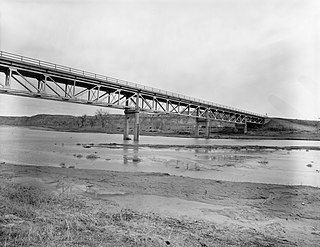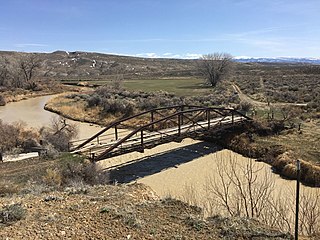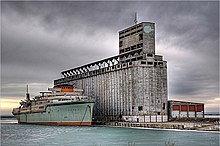Luten Bridge Company and variations such as Luten Engineering Company was the name of a number of different bridge building companies in the United States during the early- to mid-20th century. Each had rights to build concrete Luten arch bridges, according to the patented designs of Daniel B. Luten, of Indianapolis.
The Kansas City Bridge Company was a bridge building company that built many bridges throughout the Midwest United States in the early 1900s. The company was founded in 1893 and ceased business around 1960.

The Western Bridge and Construction Company, located in Omaha, Nebraska, was one of the foremost bridge engineering and manufacturing companies in the Midwestern United States. Several of their bridges are now listed on the National Register of Historic Places. Their headquarters were located in the Bee Building in Downtown Omaha.

The EFP Bridge spans Owl Creek in Hot Springs County, Wyoming. The bridge was erected in 1919–20 by the Monarch Engineering Company of Denver and spans 124 feet (38 m) with a total length of 126 feet (38 m). The rigid 7-panel Parker (camelback) through-truss was nominated for inclusion on the National Register of Historic Places as one of forty bridges throughout Wyoming that collectively illustrate steel truss construction, a technique of bridge design that has become obsolete since the mid-twentieth century. The bridge is supported on sandstone abutments and has a timber deck, 15 feet (4.6 m) in width.

Canton Bridge Company was a firm that was later incorporated into the American Bridge Company. The firm was established in Canton, Ohio, in 1892 and became one of the nation's biggest bridge-builders during the early 20th century. It designed and/or built many bridges that later became listed on the U.S. National Register of Historic Places (NRHP).
The Iowa Bridge Company was a company that designed and built many bridges that are listed on the U.S. National Register of Historic Places.

The Pueblo Bridge Co. is a firm that built a large number of bridges in the United States. Several are listed on the U.S. National Register of Historic Places.

The Missouri Valley Bridge & Iron Co., also known as Missouri Valley Bridge Company, was a engineering, construction, and steel fabrication firm that operated through the late nineteenth and most of the twentieth centuries. It was based in Leavenworth, Kansas, with a WWII facility in Evansville, Indiana.
Topeka Bridge & Iron Co. was a bridge company. Its works include many bridges that are now listed on the U.S. National Register of Historic Places. Its Canyon Diablo Bridge was a concrete Luten arch bridge built in 1914. Its Amelia Park Bridge, for another example, was built in 1914.

The Midland Bridge Company is a firm based in Kansas City, Missouri, United States, that has built numerous bridges. Several of its works are listed on the U.S. National Register of Historic Places (NRHP).

The Groton Bridge Co. was an American construction company.

The Virginia Bridge & Iron Co., also known as Virginia Bridge Company, was a bridge company based in Roanoke, Virginia.

The Omaha Structural Steel Works was a company also known as Omaha Steel Works and as Omaha Structural Steel Bridge Co. in Omaha, Nebraska.
Architects of the National Park Service are the architects and landscape architects who were employed by the National Park Service (NPS) starting in 1918 to design buildings, structures, roads, trails and other features in the United States National Parks. Many of their works are listed on the National Register of Historic Places, and a number have also been designated as National Historic Landmarks.

The EAU Arvada Bridge was a Parker through truss bridge located near Arvada, Wyoming, which carried Sheridan County Road CN3-38 across the Powder River. The bridge was built in 1917 by the Monarch Engineering Company of Denver. The single-span 8-panel bridge was 162 feet (49 m) long and was connected by steel pins. When nominated to the National Register of Historic Places in 1982, it was one of only two Parker through truss bridges remaining in Wyoming.

The CKW Bridge over Powder River is a Pratt deck truss bridge near Arvada, Wyoming, which carries US 14/US 16 across the Powder River. The bridge was built from 1932 to 1933 by the W. P. Roscoe Company. The 452-foot (138 m) bridge has three continuous main spans and two shallow approach spans. It is the only continuous truss bridge still in use on a Wyoming road and one of only two deck truss bridges built on a major highway.

The DMJ Pick Bridge is a Parker through truss bridge located near Saratoga, Wyoming, which carries Carbon County Road CN6-508 across the North Platte River. The bridge was built from 1909 to 1910 by contractor Charles G. Sheely; it was originally located south of Fort Steele. In 1934, the bridge was moved up the river to its current location, as a new bridge had been built at its original site five years earlier. The bridge is the only Parker truss bridge remaining in Wyoming, after the Arvada Bridge was replaced in 1990.

The EJP County Line Bridge is a Camelback pony truss bridge located near Hyattville, Wyoming, which carries Big Horn County Road CN9-60 across the Nowood River. The bridge was built in 1917 by the Monarch Engineering Company. As the bridge was originally thought to connect Big Horn and Washakie Counties, the two counties split the cost of the bridge, with each paying for one abutment and the two splitting the cost of the superstructure; this is the only recorded case of two Wyoming counties purchasing a bridge in such a way. Further surveys determined that the bridge is actually located entirely within Big Horn County. At 102 feet (31 m) long, the bridge is the longest Camelback truss bridge in Wyoming.

The EJE Bridge over Shell Creek is a Warren pony truss bridge located near Shell, Wyoming, which carries Big Horn County Road CN9-57 across Shell Creek. The bridge was built in 1920 by the Midland Bridge Company, the only firm to bid for the bridge contract. At 60 feet (18 m) long, it is the longest known example of a Warren pony truss bridge in Wyoming.

The EJZ Bridge over Shoshone River is a Warren pony truss bridge located near Lovell, Wyoming, which carries Big Horn County Road CN9-111 across the Shoshone River. Contractors McGuire and Blakeslee built the bridge from 1925 to 1926 using a design by the Wyoming Highway Department. The 389-foot-6-inch (118.72 m) bridge has four spans, the second-most of any truss bridge in Wyoming.

















